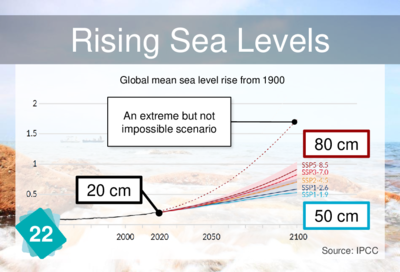En-en adult card 22 sea level rise
Card #22: Sea Level Rise
| Causes | Consequences | |

|
Since 1900, sea level has risen by 20 cm.
Sea level rise is caused by the thermal expansion of ocean waters, and the melting of glaciers and continental glaciers.
Explanation
It is important to note that the forecasts for the rise in water levels are very conservative. Some phenomena, which are understood qualitatively but not quantitatively, are simply not quantified in the IPCC report.
This is the case of mills, for example. These are passages between the water in glacial lakes on the surface of the ice caps and the bedrock. Once the water enters these passages, it lubricates the contact between the bedrock and the ice cap, making it easier for the glaciers to drift towards the sea.
The figures for sea level rise will therefore most likely be revised upwards in future reports.
Other possible links
Links to be avoided
Melting of Sea Ice is not responsible for the rise in water levels.
More information on the link explanation page.
To go further
Key points
- The water expands very little. How can warming of the ocean by a tenth of a degree result in a rise in the water level? A first answer is that the ocean is 4000m deep on average, so a very small expansion is enough to make it a few centimetres deep. A more complete answer is to talk about the coefficient of expansion of water. It happens to depend on the temperature. Between 0 and 4°C, it is negative, i.e. the water contracts when it heats up. This value of 4°C is precisely the value of the temperature at the bottom of many lakes. This is logical because water that is either colder or warmer is lighter than water at 4°C. It is at 4°C that the water is the densest, so it ends up at the bottom. If we look at the temperature of the ocean, over all latitudes and at all depths, it varies for the most part between 0°C and 10°C, with an average value probably around 4°C. So in theory, around this value, the coefficient of expansion is zero. Therefore, how much can the ocean expand? In reality, it is in areas where the water temperature is higher that the ocean expands. When the water reaches 20°C, or even much higher, over several tens of metres, then there is reason to see water dilation in these areas. We can then imagine how difficult it is to calculate the rise in the water level: to do so, we need to know with great precision the distribution of water temperatures, including at depth, and also to know the temperature rise in certain areas. Multiplying the two gives a result.
- Another important point: the rise in water levels is due both to an increase in its mass (melting of glaciers and ice caps) and to an increase in volume (expansion of water). This increase in water volume is not homogeneous: it takes place in areas where water expands, i.e. in warm areas. This increase is not homogeneous, which means that the water level is not horizontal! Yes, hot water floats in relation to cold water, it's just that we rarely have the opportunity to check it.
- The melting of the cryosphere (ice caps and glaciers) has become the dominant factor in sea level rise[2].
Numbers
About 11% of the world's population lives below 10 metres, and these areas produce 14% of domestic products[3].
References
- ↑ Page 100 du Résumé Technique du 5ème rapport du GIEC (French)
- ↑ Valérie Masson-Delmotte, Conference in Lyon, 58'51 https://www.youtube.com/watch?v=73qkhnhbyGI&feature=youtu.be (French)
- ↑ IPCC, Special report on cryosphere and oceans